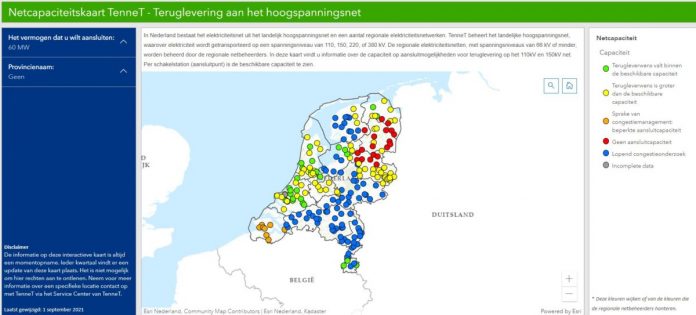Dutch electricity transmission system operator (TSO) Tennet has published on its website an interactive online map showing the locations in the country where the power grid is most congested.
The grid operator said the map gives solar and wind project developers as well as regional grid operators direct insight into where and how much capacity is available at Tennet’s high-voltage stations. Maximum available transport capacity has already been reached in a number of regions, the company warned, noting that if a high-voltage substation is marked in red, then there is currently no transport capacity available at that moment. It is also still possible to request congestion management if a substation is marked in blue.
Tennet specified that the map will be updated on a quarterly basis and that changes may occur if additional capacity becomes available due to an expansion of the infrastructure or if a station has reached its maximum capacity due to new grid-connection requests.
“The current map currently shows a large number of blue areas,” Tennet stated. “Due to the rapid growth of sustainable production, many applications have been made for a connection to the grid in these – mostly rural – regions.”
Tennet issued a warning earlier this month about the network congestion caused by the “rapid growth of wind and solar farms,” this time in the Gelderland and Flevopolder regions in the central and eastern Netherlands. Tennet said it expected to invest €450 million in upgrading the grid in the areas concerned. It is also exploring network congestion management using “a method based on the electricity market to create more space on the grid and at the same time prevent overloading of the electricity network.”
The Netherlands could reach between 38 GW and 125 GW of total installed solar capacity by 2050, according to a recent report by Netbeheer Nederland, the Dutch association of national and regional electricity and gas network operators.
Dutch power company Liander recently implemented several measures to increase grid capacity in several Dutch regions afflicted by grid constraints, which are preventing more renewable energy plants from coming online. These include the deployment of two giant transformers and the application of congestion management to a bottleneck in the grid.
In November 2020, Netbeheer Nederland and the Dutch renewable energy associations De Nederlandse Vereniging Duurzame Energie (NVDE) and Holland Solar signed a preliminary agreement to ensure faster and cheaper grid connection of large-scale solar power plants to the network.






